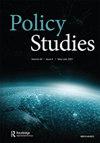Reconceptualizing transfer pathways: policy transfer and armed UAV proliferation
IF 2.2
4区 管理学
Q2 PUBLIC ADMINISTRATION
引用次数: 0
Abstract
ABSTRACTWhile policy transfer remains a widely used approach for understanding public policy formation, several conceptual shortcomings limit the approach’s capacity for explanation. Notably, the concept of “transfer pathway” lacks a precise conceptual definition and empirical specification, limitations reflecting broader gaps in the policy transfer literature. This article contributes to the study of policy transfer by explicitly defining transfer pathway and demonstrating how a more expansive transfer pathway conceptualization can increase analytical granularity. Conceptual insights developed here are empirically applied to U.S. State Department announcements in late 2020 to sell armed unmanned aerial vehicles (UAVs), first to the United Arab Emirates and then Morocco. Such cases illustrate two novel transfer pathways, the tortuous pathway and the foreign policy pathway, offering a sketch of how governments transfer policies in the foreign and security policy domain. By employing process tracing, specific causal process observations associated with the arms transfer processes in each instance can be identified to better understand specific transfer outcomes.KEYWORDS: Policy transfertransfer pathwayUAVarms salesforeign policy Disclosure statementNo potential conflict of interest was reported by the author(s).Notes1 Different “objects” subject to transfer include abstract objects (e.g., ideas, ideologies, discourses) as well as more concrete ones (e.g., policy designs and instruments, administrative regulations, governing structures).2 Citation figures as of September 2023.3 Newmark’s “diffusion continuum” identifies policy diffusion and policy convergence, respectively, as the broadest forms of denoting policy spread, followed by policy transfer. Per Newmark, policy transfer is a “more specific form of policy diffusion” since it accounts for when “conscious knowledge of policy is used in policy development elsewhere” (Citation2002, 171).4 Reviews by Newmark (Citation2002), Knill (Citation2005), Marsh and Sharman (Citation2009) and Stone (Citation2012) detail the complementary nature of diffusion and policy transfer.5 Along with policy mobilities, geographers and sociologists have also sought to build on policy transfer logic by developing notions of policy assemblages, mutations and circulation (McCann and Ward Citation2013; Baker and Walker Citation2019).6 This contrasts with closed compound words (which omit the space between two source words), hyphenated words and portmanteaus.7 As a policy process theory, MSA’s “most valuable attribute” remains “its ability to deal with timing – that is, the joining together of circumstances at a particular point in time” (Howlett, McConnell, and Perl Citation2016, 279–280).8 Kingdon (Citation2003) uses the concept of ‘spillover’ to convey how success in one policy area creates opportunities for success in other policy areas.9 Between the FMS ($55 billion) and DCS ($115 billion) programs, the U.S. government manages approximately $170 billion annually in the sales of defense equipment to foreign partners (U.S. Department of State Citation2021a).10 See Cooper (Citation2014) for a discussion of national security directives and unilateral presidential power regarding arms transfers and national security.11 See Congressional Research Service (Citation2021a) for a discussion of recent US-UAE defense cooperation and Congressional Research Service (Citation2021b) for a discussion of the congressional review process of arms sales.12 Per media accounts, Morocco used armed UAVs for the first time in 2021, purportedly against Polisario Front leaders representing the region’s indigenous Sahrawi people and staking a claim to territorial sovereignty.Additional informationNotes on contributorsStephen CeccoliStephen Ceccoli is the P.K. Seidman Professor of Political Economy at Rhodes College, Memphis, TN, where he teaches in the International Studies Department. His research interests include domestic and comparative aspects of regulation, public opinion and policymaking. He is the author of Pill Politics: Drugs and the FDA (Lynne Rienner) and has published in various journals, including International Studies Quarterly, Social Science Quarterly, Political Behavior, Presidential Studies Quarterly, and Policy Studies.重新定义转移途径:政策转移和武装无人机扩散
摘要虽然政策转移仍然是理解公共政策形成的一种广泛使用的方法,但一些概念上的缺陷限制了该方法的解释能力。值得注意的是,“转移路径”的概念缺乏精确的概念定义和实证规范,这一局限性反映出政策转移文献中存在较大的空白。本文通过明确定义转移路径并展示更广泛的转移路径概念化如何增加分析粒度来促进政策转移的研究。在此开发的概念见解被经验地应用于美国国务院在2020年底宣布的出售武装无人机(uav),首先是阿拉伯联合酋长国,然后是摩洛哥。这些案例说明了两种新的转移路径,即曲折路径和外交政策路径,为政府如何在外交和安全政策领域转移政策提供了一个草图。通过过程追踪,可以识别与每个实例中的武器转让过程相关的具体因果过程观察,以更好地了解具体的转让结果。关键词:政策转移转移途径武器销售对外政策披露声明作者未报告潜在利益冲突。注1不同的转移对象包括抽象对象(如思想、意识形态、话语)和更具体的对象(如政策设计和工具、行政法规、治理结构)Newmark的“扩散连续体”(diffusion continuum)分别将政策扩散(policy diffusion)和政策收敛(policy convergence)确定为表示政策扩散的最广泛形式,其次是政策转移(policy transfer)。根据纽马克的观点,政策转移是一种“更具体的政策扩散形式”,因为它解释了“有意识的政策知识何时被用于其他地方的政策制定”(citation2002,171)Newmark (Citation2002)、Knill (Citation2005)、Marsh和Sharman (Citation2009)以及Stone (Citation2012)的评论详细阐述了扩散和政策转移的互补性除了政策流动性,地理学家和社会学家还试图通过发展政策组合、突变和循环的概念来建立政策转移逻辑(McCann和Ward Citation2013;贝克和沃克引文(2019)这与封闭复合词(省略两个源词之间的空格)、连字符词和混合词形成对比作为一种政策过程理论,MSA的“最有价值的属性”仍然是“它处理时间的能力——也就是说,在特定的时间点将各种情况结合在一起”(Howlett, McConnell, and Perl Citation2016, 279-280)Kingdon (Citation2003)使用“溢出效应”的概念来表达一个政策领域的成功如何为其他政策领域的成功创造机会在FMS(550亿美元)和DCS(1150亿美元)计划之间,美国政府每年管理着大约1700亿美元的国防设备销售给外国合作伙伴(美国国务院引文2021a) 10参见Cooper (Citation2014)关于国家安全指令和单方面总统权力关于武器转让和国家安全的讨论参见美国国会研究处(Citation2021a)关于最近美国-阿联酋防务合作的讨论,参见美国国会研究处(Citation2021b)关于国会对军售的审查过程的讨论根据媒体报道,摩洛哥在2021年首次使用武装无人机,据称是针对代表该地区土著撒哈拉人民的波利萨里奥阵线领导人,并声称拥有领土主权。作者简介stephen Ceccoli stephen Ceccoli是田纳西州孟菲斯市罗德学院政治经济学P.K. Seidman教授,在国际研究系任教。他的研究兴趣包括国内和比较方面的监管,公众舆论和政策制定。他是《药丸政治:药物和FDA》(Lynne Rienner)一书的作者,并在各种期刊上发表文章,包括《国际研究季刊》、《社会科学季刊》、《政治行为》、《总统研究季刊》和《政策研究》。
本文章由计算机程序翻译,如有差异,请以英文原文为准。
求助全文
约1分钟内获得全文
求助全文
来源期刊

Policy Studies
PUBLIC ADMINISTRATION-
CiteScore
5.40
自引率
4.50%
发文量
34
期刊介绍:
These changes at the structural level of the global system have impacted upon the work of public organizations either directly or indirectly and have broadened the field of action in policy studies. It has five main areas of intellectual interest: 1.To broaden the lens of policy analysis through the publication of research which locates policy-making within a theoretical, historical or comparative perspective. 2.To widen the field of enquiry in policy analysis through the publication of research that examines policy issues in a British, comparative, international or global context. 3.To promote constructive debate on theoretical, methodological and empirical issues in policy analysis.
 求助内容:
求助内容: 应助结果提醒方式:
应助结果提醒方式:


